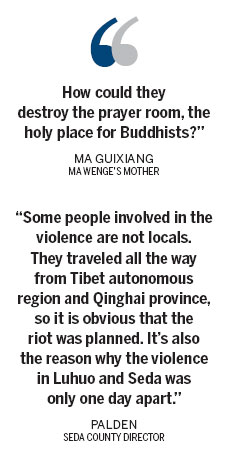Riots linked to organized crime and subversion
Updated: 2012-02-06 08:12
By Cui Jia (China Daily)
|
||||||||
154 km north
|
|
The police station in Seda county was attacked on Jan 24, one day after the violence broke out in Luhuo.
About 200 people, mostly in their 20s and 30s, started to gather at Jinma Square in Seda town around 2 pm, according to Palden, the county director.
Around 2:40 pm, he said, they began to attack a police box near the square using Tibetan knives, rocks and flaming gas bottles. Gunshots were heard.
One participant died, and another was injured when the police fought back, Palden said. The riot lasted about 20 minutes before the mob was dispersed. Thirteen people were arrested.
The riot frightened people. Yeshe Lhamo, 28, a nun at the local Buddhism academy, said she didn't feel comfortable going into the county seat until several days had passed. "People are scared, and the atmosphere in the temples is tense," she said. "Violence is against monastic order. No one wants to see such things happen."
Daklha, 30, owns a women's accessory shop beside Jinma Square, and her shop was closed for several days after the violence. "My business is seriously affected. I don't want to see the violence. Any blood-shedding is bad," she said. "We want a peaceful life."
Jobs, better future
Palden, who is 48 and ethnic Tibetan, has been the county director in Seda for four years. "Some people involved in the violence are not locals," he said. "They traveled all the way from Tibet autonomous region and Qinghai province, so it is obvious that the riot was planned. It's also the reason why the violence in Luhuo and Seda was only one day apart."
Seda, situated on the southeastern edge of Qinghai-Tibet Plateau, is a vast pasturing region with an average elevation of 4,100 meters above sea level. About 45,000 people live in 134 villages scattered over 9,000 sq km.
Seda is also home for more than 10,000 Buddhist monks living in 31 temples.
"The majority of the crowds are young people who do not have jobs," Palden said, and they have become a factor that affects Seda's overall stability. He also noticed that the behavior of mobs has become more violent over the years.
"Young people are the group of people who are most active on the Internet, so they are easy to be instigated by foreign separatists," he said.
"So the priority is to improve life quality in Seda county and provide enough job opportunities for the young people," Palden said. "If one person was involved in separatist activity, then the whole family and village would be affected."
To help Tibetan youth in Sichuan seek employment, the Sichuan government launched what it calls the 9+3 campaign in Tibetan-inhabited areas in 2008. Besides the nine years of education that is compulsory nationwide, Tibetan young people are offered three years' free vocational education covering 60 subjects, including nursing and mechanics, in 90 schools in Sichuan.
Yongqing from Seda is proud of his 19-year-old son, Dawa. "The 9+3 campaign has changed him and his future," Yongqing said.
Before Dawa was offered the opportunity to study information technology in Chengdu, he was a rebel, Yongqing said. "He was lazy and often involved in troubles.
"After two years' study in Chengdu, I feel that Dawa has grown up," Yongqing said. "Besides gaining knowledge, he is also aware that he has to be responsible for the family and the society."
"The 9+3 campaign has made me become confident and have the courage to fight for my future," Dawa said. "I know my fate is in my own hands."

 Relief reaches isolated village
Relief reaches isolated village
 Rainfall poses new threats to quake-hit region
Rainfall poses new threats to quake-hit region
 Funerals begin for Boston bombing victims
Funerals begin for Boston bombing victims
 Quake takeaway from China's Air Force
Quake takeaway from China's Air Force
 Obama celebrates young inventors at science fair
Obama celebrates young inventors at science fair
 Earth Day marked around the world
Earth Day marked around the world
 Volunteer team helping students find sense of normalcy
Volunteer team helping students find sense of normalcy
 Ethnic groups quick to join rescue efforts
Ethnic groups quick to join rescue efforts
Most Viewed
Editor's Picks

|

|

|

|

|

|
Today's Top News
Health new priority for quake zone
Xi meets US top military officer
Japan's boats driven out of Diaoyu
China mulls online shopping legislation
Bird flu death toll rises to 22
Putin appoints new ambassador to China
Japanese ships blocked from Diaoyu Islands
Inspired by Guan, more Chinese pick up golf
US Weekly

|

|







